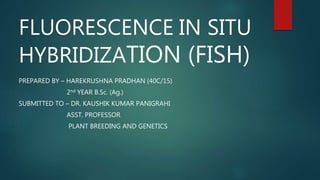
FISH Technique Guide
- 1. FLUORESCENCE IN SITU HYBRIDIZATION (FISH) PREPARED BY – HAREKRUSHNA PRADHAN (40C/15) 2nd YEAR B.Sc. (Ag.) SUBMITTED TO – DR. KAUSHIK KUMAR PANIGRAHI ASST. PROFESSOR PLANT BREEDING AND GENETICS
- 2. WHAT IS FISH ? Fluorescent in situ hybridization (FISH) is a molecular cytogenetic technique that uses fluorescent probes that bind to only those parts of the chromosome with a high degree of sequence complementarity. It was developed by biomedical researchers in the early 1980s. It is a technique used to detect the presence or absence and location of specific gene sequences. FISH is a process which vividly paints chromosomes or portions of chromosomes with fluorescent molecules.
- 3. It identifies chromosomal abnormalities & aids in gene mapping, toxicological studies, analysis of chromosome structural aberrations, and ploidy determination. FISH looks specifically at the one specific area of a chromosome only. A variety of specimen types can by analyzed using FISH. The intact cells are attached to a microscope slide using standard cytogenetic methods. A technique that hybridizes a DNA nucleic acid probe to a target DNA sequence contained within a cell nucleus.
- 4. Interpretation of FISH Each fluorescently labeled probe that hybridizes to a cell nucleus in the tissue of interest will appear as a distinct fluorescent dot Diploid nuclei will have two dots If there is duplication in the region of interest, the gain will result in more than two dots If there is a loss in the region of interest, one or zero dot will result If a small deletion is present in the region complementary to the probe, the probe will not hybridise If a duplication is present, more of the probe is able to hybridise.
- 5. Probes Probe is a nucleic acid that can be labelled with a marker which allows identification and quantitation will hybridize to another nucleic acid on the basis of base complementarity A part of DNA (or RNA) that is complementary to certain sequence on target DNA (i.e. DNA of the patient) Plasmid, phage DNA, cosmid (or combination of phage and plasmid DNA PCR-product (amplification of certain segment of chromosomal DNA)
- 6. TYPES OF PROBES Scientists use three different types of FISH probes, each of which has a different application LOCUS SPECIFIC PROBES ALPHOID or CENTROMERIC REPEAT PROBES WHOLE CHROMOSOME PROBES Locus specific probes bind to a particular region of a chromosome. This type of probe is useful when scientists have isolated a small portion of a gene and want to determine on which chromosome the gene is located, or how many copies of a gene exist within a particular genome.
- 7. Alphoid or Centromeric repeat probes are generated from repetitive sequences found in the middle of each chromosome. Researchers use these probes to determine whether an individual has the correct number of chromosomes. These probes can also be used in combination with "locus specific probes" to determine whether an individual is missing genetic material from a particular chromosome. Whole chromosome probes are actually collections of smaller probes, each of which binds to a different sequence along the length of a given chromosome. Using multiple probes labelled with a mixture of different fluorescent dyes, scientists are able to label each chromosome in its own unique colour. The resulting full-colour map of the chromosome is known as a spectral karyotype. Whole chromosome probes are particularly useful for examining chromosomal abnormalities, for example, when a piece of one chromosome is attached to the end of another chromosome.
- 8. How does FISH work? FISH is useful, for example, to help a researcher or clinician identify where a particular gene falls within an individual's chromosomes. The first step is to prepare short sequences of single-stranded DNA that match a portion of the gene the researcher is looking for. These are called probes. The next step is to label these probes by attaching one of a number of colors of fluorescent dye. DNA is composed of two strands of complementary molecules that bind to each other like chemical magnets.
- 9. Since the researchers' probes are single-stranded, they are able to bind to the complementary strand of DNA, wherever it may reside on a person's chromosomes. When a probe binds to a chromosome, its fluorescent tag provides a way for researchers to see its location.
- 10. In which conditions we have to indicate FISH analysis? The material doesn't contain metaphase chromosomes Analysis of complicated chromosomal rearrangements Identification of marker chromosomes Diagnosis of sub-microscopic (cryptic) chromosomal rearrangements
- 11. Multi Colour FISH – A SPECIAL TYPE Multicolour FISH can provide “colourized” information relative to chromosome rearrangements, especially useful in specimens where chromosome preparations are less than optimal for standard cytogenetic banding analysis
- 12. FISH Procedure Denature the chromosomes Denature the probe Hybridization Fluorescence staining Examine slides or store in the dark
- 15. Hybridization
- 16. Visualization of the Probe DNA probe is labelled with a coloured fluorescent molecule. This fluorescent molecule remains attached to the DNA during the hybridization process The molecule emits a particular colour when viewed through a fluorescence microscope that is equipped with the appropriate filter sets.
- 17. USES OF FISH Less labour-intensive method for confirming the presence of a DNA segment within an entire genome than other conventional methods like Southern blotting FISH method used in this study was suitable for the detection of simazine-degrading bacteria and could be a useful indicator of the potential of soil bioremediation. In environmental microbiology, FISH works have been carried out with samples originated from sea water, rivers, lakes, biofilms, soil, plants and animals. Fluorescent probes, like an intelligent stain, hybridize exclusively with the rRNA of the chosen microorganisms allowing to:
- 18. I) identify the microorganisms in environmental samples without the utilization of culture media II) quantify the microorganisms directly in the sample III) determine the morphology IV) describe the spatial distribution V) determine the natural relation between species.
- 19. THANK YOU
